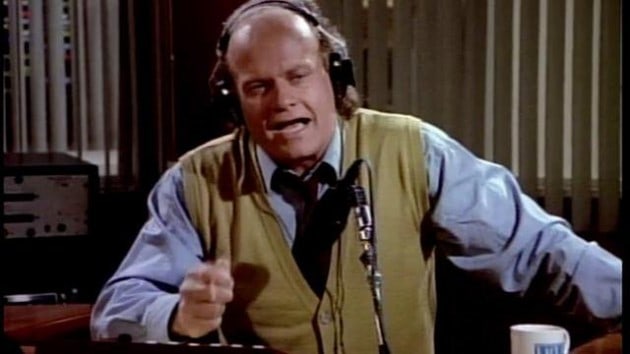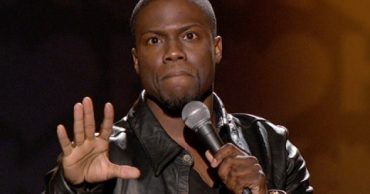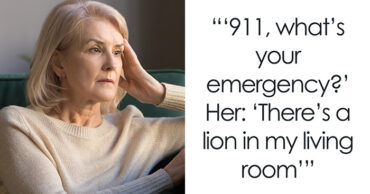
Rediscovering the Origins of Frasier
Over the next few months, many of us at TVOvermind will be participating in our summer rewatch project and reviewing some of our favorite series of all-time that have left a major stamp on television and pop culture in general. One of the shows Randy Dankievitch will be taking a look back at is “Frasier,” which ran from 1993-2004 on NBC.
Frasier‘s creation is an interesting story. At one point conceived as a show about a genius paraplegic with a “street smart” Latina house maid (what a classic that show would’ve been), Frasier’s early development follows a path from the end of Cheers through a cameo by Kelsey Grammar on Wings, a pitch to NBC, and then a lot of tweaking to create the show that would eventually air longer than Seinfeld and Friends (which would debut in the fall of 1994), and nearly match Cheers’ run on the network, falling a mere six half hours short of its predecessor’s 270 episodes.
From Denver to Seattle: The Birth of a Classic
Even more fascinating is how the show ended up taking place in Seattle. According to an anecdote on Ken Levine’s blog, Frasier was originally going to be set in Denver, until Colorado voters passed a massive initiative banning gay rights laws in the state (later that year, the courts would determine Colorado’s initiative violated the Constitution). So the writers of the show decided to move Fraiser even further west, to Seattle, allowing it to truly separate itself, at least in terms of mileage, from the iconic series that introduced America to Frasier Crane (and to allow the writers to not have to constantly be pressured into having Cheers actors guest star on the show).
The result of those efforts, “The Good Son,” aired on September 16, 1993, and immediately establishes itself as something quite different than Cheers. The opening scene features Roz and Frasier on the radio, Frasier summing up the six months between the end of Cheers until now: him and Maris broke up for good, and feeling like his life had grown stagnant, he moved out to Seattle to start a new career as a radio host and a bachelor with a taste for fine European furniture (no sherry in the pilot, unfortunately). As overt as that opening monologue feels, it establishes a different tone than the iconic comedy it was spun from, with much longer, uninterrupted monologues, a much faster pace – and of course, the mid-life angst that became so prominent in the early 1990s, with Frasier hinting towards a lonely, confusing six months since he moved from Boston to Seattle.
Introducing the Characters: The Good Son
From there, “The Good Son” takes a fairly pedestrian path to introducing its characters; one by one, each of them is introduced, most of them in their own short vignette preceded by the ever-familiar Frasier intertitles (“The Father,” “The Son,” “Eddie” are the three here). While the manner in which characters are introduced is a little too familiar, the writing informing it is unusually strong (not to mention the performances). Meeting Niles in a coffee shop, we get our first Maris story and a lovely insight into how particular he is (as well as being a complete germaphobe). Here, Frasier begins to develop the high-brow wit it would be acclaimed and ridiculed equally alike for, though without the deeper psychological tenants later episodes would explore; it’s all Wasille chairs and arguments with the gardener, hardly the most rewarding of Frasier’s eventual comedic centerpiece.
However, Niles is quite a distinct character in “The Good Son”; as is Marty, Frasier’s father, who provides the emotional centerpiece of the pilot. How “The Good Son” builds out the relationship – or lack thereof – between Marty and Frasier is the highlight of this first episode; their unfamiliarity explained by their equal dismissal of each other’s lifestyle, and how uncomfortable they are trying to share the same space. And as the episode moves away from its character introductions and into its story, it reveals a moving pathos about life taking unexpected turns. With Frasier still recovering from his divorce, and Mary’s retirement plans ruined by his hip injury, father and son find themselves reluctantly drawing closer to each other.
Unwinding the Tension: A Touching Resolution
As old conflicts linger, so do personal reservations, and “The Good Son” is all about unwinding the tension between Frasier and his father, a tough task to do in a 23 minute window (especially after the conflict comes so close to the end of the episode). But it does, in a wonderful scene where Marty calls in to Frasier’s radio show to hash out their resentments towards each other. The smartest decision here was keeping Marty off screen; it not only speaks to how difficult it is for Marty to express himself (he doesn’t want to be seen, embarrassed to show his feelings), but to how much they both need each other to heal and move on from the things they’ve lost, or had to leave behind.
That touching moment is one all pilots aim for, and many miss, and after a solid, if unspectacular first two acts, the resolution of “The Good Son” is wildly satisfying, providing a clean line to the heartbeat of the show. Such a heavy focus on this relationship in the second half doesn’t give a lot of room to expand on Niles, Daphne Moon (Marty’s new physical therapist), and Roz Doyle, Frasier’s producer, but they are in service of an integral moment (and with 263 episodes to follow, there’s plenty of time to get to know them). In tumultuous periods of life, we always turn to family, and “The Good Son” never forgets that, ending on one of the strongest scenes you’ll ever see in a show’s first episode.
Creating a Lived-In Comedy: The Good Son’s Success
People always talk about how a comedy needs to feel “lived in”; with such a well developed rapport between actors, the only thing “The Good Son” had to do was build those out with interesting details. And it does that, and even takes things a step farther. The father/son emotional play might be an easy one to employ, but it takes a careful hand to execute it as well as Frasier does (“You hear that? I said thank you!!” is a line that kills me, even though I’ve heard it a dozen times), not to mention surrounding it with a cast of intriguing, hilarious characters.
Other thoughts/observations:
– Frasier’s advice to a caller depressed over a breakup: “You’re not mourning the loss of your boyfriend. You’re mourning the loss of what you thought your life was going to be. Let it go – things don’t necessarily work out how they were planned. That’s not bad; things have a way of working out anyway.”
– Frasier’s first closing montage features Frasier, Daphne, and Marty watching TV, while Eddie stares intently at Frasier.
– “Have I ever told you the story of Loopie Velez?”
– Frasier to Roz: “Do you think I’m fragile, like a piece of Lalique?”
– “I thought you liked my Maris.” “I do, from a distance.”
– Jane Leeves stretching out the word “psyyyyyy-chic”; is there anything more fun to watch on TV?
– “Golden Acres: We Care, So You Don’t Have To.”
– The double entendres of Frasier are glorious from the get go: “I need to do something to calm me down. Double espresso, please!”
– Who has an apartment where the bathroom is attached to the living room, right next to the door? Such an odd location – and one the show would keep for years, including an episode where John McGinley fixes a toilet.
– Frasier: “I’m supposed to give up my study, where I have my most profound thoughts?” Marty: “Use the can like the rest of us!”
– “Remember what Mom used to say: a handshake is just as good as a hug.” If anyone remembers Frasier’s mother from way, way back in Season 3 of Cheers, that sounds exactly like Dr. Hester Rose Crane.
[Photo via NBC]
 Follow Us
Follow Us





